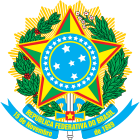| This article is part of a series on the |
| Politics of Brazil |
|---|
 |
Executive
|
| Legislative |
Judiciary
|
| Law |
| Administrative divisions |
|
Elections
Recent elections |
Foreign relations
|
| Related topics |
Parliamentary elections were held in Brazil on 14 October 1934 to elect members of the Chamber of Deputies and state legislatures.
Background
Following the Brazilian Revolution of 1930, a constitutional assembly was elected in 1933 and drew up a new constitution, which came into force on 16 July 1934. It provided for a federal state with a bicameral parliament consisting of a 300-member Chamber of Deputies (of which 250 were directly elected and 50 selected by union and employer bodies) and a Senate consisting of two members from each state, who would be elected by state legislatures.
After the constitution was promulgated, the Assembly was converted into a Chamber of Deputies and elected Getúlio Vargas as president the following day.
Electoral system
The 250 directly elected members were elected by open list proportional representation, with states acting as constituencies. Voters could cast preferential votes for candidates from multiple parties.
Results
Of the 250 elected members, 142 were supporters of Vargas, 76 were from the opposition and 32 were independents.
References
- C. Peixoto-Mehrtens (2010). Urban Space and National Identity in Early Twentieth Century São Paulo, Brazil: Crafting Modernity. p. 2008.
- ^ Joseph Smith (2014). A History of Brazil. p. 143.
- ^ Brazil, a Country Study. 1983. p. 41.
- ^ Jairo Nicolau (2007). "The open-list electoral system in Brazil" (PDF). Dados. 3.
- John W. F. Dulles (2014). Vargas of Brazil: A Political Biography. p. 157.
| Presidential elections | |
|---|---|
| Parliamentary elections | |
| Gubernatorial elections | |
| State elections | |
| Municipal elections | |
| Regency elections | |
| Referendums | |